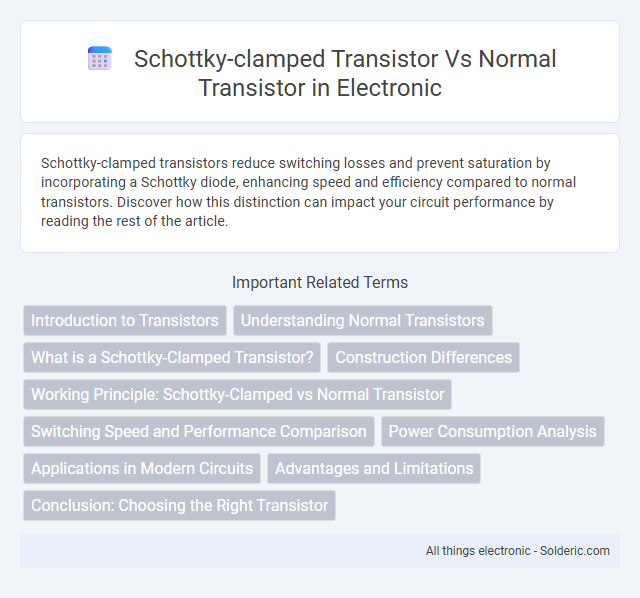Schottky-clamped transistors reduce switching losses and prevent saturation by incorporating a Schottky diode, enhancing speed and efficiency compared to normal transistors. Discover how this distinction can impact your circuit performance by reading the rest of the article.
Comparison Table
| Feature | Schottky-Clamped Transistor | Normal Transistor |
|---|---|---|
| Clamping Method | Schottky diode clamp | No clamp, standard BJT operation |
| Switching Speed | Faster due to reduced storage time | Slower, higher storage time |
| Storage Time | Minimized by Schottky barrier preventing saturation | Longer due to transistor saturation |
| Power Dissipation | Lower power loss during switching | Higher switching losses |
| Saturation Voltage (V_CE(sat)) | Higher due to Schottky diode forward voltage | Lower, transistor fully saturates |
| Applications | High-speed logic circuits, ECL | General amplification and switching |
| Complexity | More complex structure with integrated diode | Simpler, basic transistor structure |
Introduction to Transistors
Schottky-clamped transistors incorporate a Schottky diode between the base and collector to prevent transistor saturation, enhancing switching speed compared to normal bipolar junction transistors (BJTs). Normal transistors, fundamental components in electronic circuits, operate by controlling current flow through three layers (emitter, base, and collector) without the saturation protection mechanism. The Schottky clamp effectively reduces transistor storage time, making Schottky-clamped transistors ideal for high-speed digital applications and improving overall switching performance.
Understanding Normal Transistors
Normal transistors operate as fundamental semiconductor devices that control current flow with voltage applied to their base or gate terminals, enabling amplification and switching functions. They employ standard PN junctions without additional clamping elements, making them susceptible to voltage spikes and slower switching speeds compared to Schottky-clamped transistors. Understanding their structure and operational characteristics is essential for designing circuits where high-speed switching and reduced power loss are not critical constraints.
What is a Schottky-Clamped Transistor?
A Schottky-clamped transistor integrates a Schottky diode between the base and collector terminals, preventing transistor saturation and enabling faster switching speeds. This configuration reduces charge storage time compared to a normal transistor, improving performance in high-frequency applications. Your circuits benefit from lower power consumption and increased efficiency when using Schottky-clamped transistors.
Construction Differences
Schottky-clamped transistors incorporate a Schottky diode directly between the base and collector terminals, which prevents transistor saturation and reduces storage time by quickly diverting excess charge. Normal transistors lack this Schottky diode, causing prolonged saturation and slower switching speeds due to charge buildup in the base-collector junction. Understanding these construction differences can help you select the appropriate transistor type for high-speed switching applications.
Working Principle: Schottky-Clamped vs Normal Transistor
Schottky-clamped transistors integrate a Schottky diode between the base and collector, preventing the transistor from saturating by rapidly diverting excess base current, which enhances switching speed and reduces storage time. In contrast, normal transistors lack this diode, allowing deeper saturation and longer turn-off times due to charge storage in the base region. This fundamental difference in working principle makes Schottky-clamped transistors ideal for high-speed digital circuits requiring fast switching performance.
Switching Speed and Performance Comparison
Schottky-clamped transistors significantly improve switching speed by reducing storage time and preventing transistor saturation, resulting in faster switching performance compared to normal transistors. Your circuits benefit from lower propagation delays and enhanced frequency response, making Schottky transistors ideal for high-speed digital applications. Performance gains include reduced power dissipation and increased efficiency in switching operations due to the Schottky diode's ability to divert excess charge quickly.
Power Consumption Analysis
Schottky-clamped transistors reduce power consumption by minimizing transistor saturation voltage, which lowers unnecessary current dissipation compared to normal transistors. Your circuits benefit from faster switching speeds and decreased leakage currents, leading to improved energy efficiency in high-frequency applications. This makes Schottky-clamped transistors ideal for battery-powered and low-power integrated circuits.
Applications in Modern Circuits
Schottky-clamped transistors are widely used in high-speed digital circuits and logic families such as TTL due to their reduced switching times and minimized saturation voltage, improving overall performance in your computing devices. Normal transistors, while versatile and suitable for a broad range of analog and low-frequency applications, cannot match the rapid switching efficiency required in modern microprocessors and fast digital logic circuits. The integration of Schottky diodes within the transistor structure enables faster recovery and lower power dissipation, optimizing your circuit designs for speed-critical applications.
Advantages and Limitations
Schottky-clamped transistors offer faster switching speeds and reduced storage delay by preventing transistor saturation through the Schottky diode clamp, enhancing performance in high-frequency digital circuits. However, these transistors exhibit lower voltage blocking capability and higher leakage current compared to normal transistors, limiting their use in high-voltage applications. Additionally, Schottky-clamped transistors typically consume more power and have increased fabrication complexity, impacting overall efficiency and cost.
Conclusion: Choosing the Right Transistor
Schottky-clamped transistors offer faster switching speeds and reduced saturation voltage compared to normal transistors, making them ideal for high-frequency and low-power applications. Normal transistors provide higher gain and better linearity, suitable for analog circuits and general-purpose amplification. Your choice should balance speed requirements and power efficiency with the complexity and cost considerations of the specific electronic design.
Schottky-clamped transistor vs Normal transistor Infographic

 solderic.com
solderic.com